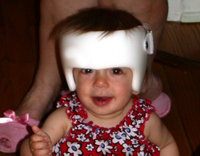Get people to laugh with you -- not at you
Remember me for who I am. While there are many people who experience a bad hair day or a fashion disaster, they have a chance to recover. Those who have been born with a facial deformity or who have suffered a facial disfigurement aren't as fortunate. I was born with Crouzon's Syndrome. This is a rare congenital disease in which the bones of the skull fuse, and stop growing too early in infancy. This causes deformities of the head, face and jaw.
I don't pretend to know or understand all disabilities. Never have I experienced the darkness of a world without vision, or the restrictions of a wheelchair or dealt with the imposed silence of hearing loss. I can't speak of these situations. But, my eyes have seen the faces of those who were clearly upset by a visually disturbing facial presence. I heard the derogatory comments about my features. For me, having a photograph taken was an exercise in historical homicide. "Yes, that's what I want ... something to preserve so that future generations can be repulsed at this genetic mutation."
I am a mouth breather. There is nothing like having the silence of a room evaporate, overpowered by the sound of your own breathing in clear, almost deafening levels; similar to the sound of a goose in heat or a pained call of a lovesick moose. Mating wild-beasts make less noise than a mouth breather. There are many features of a mouth breather that are unique. First, we forget we are mouth breathers. So despite the rapturous, melodious snorting that is habit, there is the open mouth. During the course of listening to a reply or comment by someone else, my jaw will invariably drop open unconsciously, showcasing all the beauty and wonder of the human mouth ... damp, gaping, a panorama of dental reconstruction.
Perhaps the most prominent feature of Crouzon's Syndrome are the bulging eyes or "frog eyes." They are accented due to a collapsed forehead. Therefore, with the forward position of the eyes, the sunken face takes on an out-of-proportion appearance with the top half. This is due to the lack of cheek bones which would serve to balance the eyes and equal the symmetry of the face.
Crouzon's has given me a unique people-perspective. Normal is good. Acceptable. Different is not good. Difference is uncomfortable. Difference lends itself to a wide variety of reactions, comments, suggestions and beliefs.
People who look different must be mentally challenged, perhaps slow or maybe just stupid. An understanding family goes a long way toward shattering the myth. My family seemed to travel at warped speed in the opposite direction.
My grandfather was a tower of intimidation. There was no way that I was his grandson. Someone who was born with my features was not to be claimed by an image-conscious grandparent. He possessed all the warmth and understanding of a crazed military dictator.
"Stupid" was a term he wove into his daily vocabulary long before anyone knew who 'Forrest Gump' was. Unusual face meant that the absolute last thing that you wanted to do was to draw attention to that thing sitting on your shoulders. It was sacred custom that only my grandfather cut my hair. He used to brag that he never had a minute of professional instruction. One only had to inspect the cropped head of his "client" to appreciate the accuracy of that remark. This is just what every distorted face needs -- a hairstyle performed by a nearsighted amateur devoid of the slightest degree of talent. The end result -- a horrific Ginsu-knife-like procedure, the strokes culminating in a choppy, uneven absurd style.
Perhaps people without disabilities feel the need to point out the differences in appearance of others. Do they believe that I am blissfully unaware of my nose and its resemblance to the collapsed 1-95 expressway following an earthquake. By pointing out these perceived weaknesses in others, maybe they are hoping to deflect any study from their own features.
Now as I plunge headlong into my 42nd year, I am faced with new and ongoing changes to my body, the prominent being my hair, or lack thereof. Where once there were soft, thick, curly brown locks, there is now only barren gleaming scalp. Due to numerous surgeries to correct the effects of Crouzon's Syndrome, the top of my head has more surgical scars than Penn Central has rail lines.
A person with a facial deformity may possess outstanding intelligence, but first and foremost they will be classified as "different," simply because of his looks.
To cope is to survive and the coping mechanism is within everyone. My sense of humor, has been an invaluable tool in dealing with the less-than-considerate remarks of an unaccepting public-at-large If you can get people to laugh with you -- not at you -- then the chances for embarrassment and ridicule are greatly diminished. The ability to smile through a jaw that looks like it survived the Hindenburg explosion will be a much more rewarding act than you might imagine.
Despite this age of political correctness, there will never be an overall acceptance of people with facial deformities. Society is geared to judge based on looks. The trick is to force people to look from the inside out, and when they can do that, the view is really quite normal.
COPYRIGHT 2000 Cheever Publishing, Inc.
COPYRIGHT 2001 Gale Group



